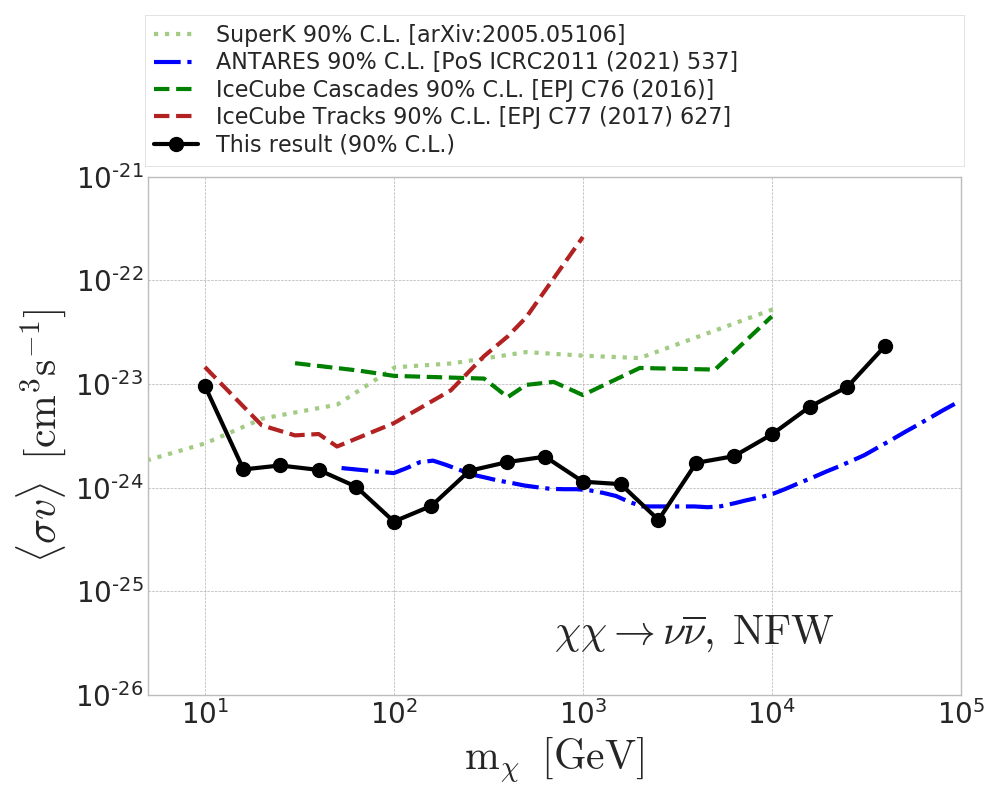Despite making up roughly 85% of all matter in the universe, dark matter (DM) still remains an enigma to astronomers and physicists. One outstanding question is the microscopic nature of DM, and thus far, no experiment has been able to determine what it is made of.
To probe the nature of DM, scientists look for the production of ordinary particles when two DM particles crash into each other and annihilate, or the disintegration of a DM particle into other particles, technically known as decay. It is thought that such processes frequently take place in regions of the universe where DM particles are densely packed, most notably the center of the Milky Way galaxy.
Neutrinos—ghostlike, nearly massless particles—could arise from DM annihilations or decay. For the scenario in which DM annihilates or decays into two neutrinos, the energies of the neutrinos are said to be “monochromatic” in that they have the same single energy. That energy is equal to either the mass of the DM particle for an annihilation or half the mass for decay. Since no other astrophysical process is known to produce such a neutrino signature or “neutrino line,” this signal, if found, could start to reveal the nature of DM.
In a new study submitted to Physical Review D, the IceCube Collaboration performed the first dedicated search with a neutrino telescope for the neutrino-line signal. The search looked at both the angular and energy information of neutrino events using a total of five years of data. Although they did not find a significant neutrino excess, new upper limits on DM annihilation and lower limits on DM lifetime were set.

The collaborators used five years of data taken with the DeepCore subdetector of the IceCube Neutrino Observatory, a gigaton-scale detector buried in ice at the South Pole. The denser DeepCore was used to test for dark matter masses ranging from 10 GeV to 40 TeV.
To search for DM, the researchers looked for a very sharp increase in neutrinos for one energy value in the direction of the Galactic center, indicative of monochromatic neutrinos. They optimized the search by using a sample consisting of mostly neutrino cascade events that allow for better reconstruction of neutrino energies. However, no excess of neutrinos was found.
“We didn’t discover DM, but thanks to this analysis we obtained limits on the intensity of such a monochromatic flux for different assumptions of the DM mass,” says Thomas Hambye, a physics professor at the Université libre de Bruxelles (ULB), one of the authors of this analysis together with ULB professor of physics Juan Antonio Aguilar and Michael Gustafsson of ULB.
The limits were significantly improved compared to a previous IceCube analysis that only looked at the direction of neutrinos. Using the same techniques, the limits for annihilation or decay into particles other than neutrinos were also improved.
“Now that IceCube has more than 10 years of available data, a new analysis, using the same general method and profiting in addition from the fact that the energy reconstruction of the neutrino event has been improved in the last years, is expected to largely improve the present sensitivity to such neutrino-line signals in a near future,” says Gustafsson.
Aguilar concludes, “All these limits provide new constraints on the cross section and lifetime, which any theoretical model that aims at a microscopic description of DM needs to fulfill.”
+ info “Search for neutrino lines from dark matter annihilation and decay with IceCube,” IceCube Collaboration: R. Abbasi et al., Physical Review D 108 (2023) 10, 102004, journals.aps.org, arXiv